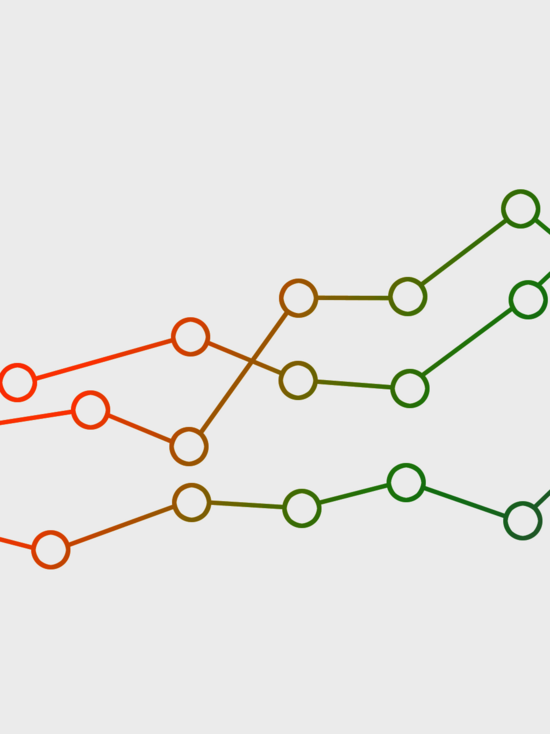What is Data Mesh?
Data Mesh is a new concept for handling data in larger companies. The approach was developed by Zhamak Dehghani, a developer at leading software company ThoughtWork. The idea behind this approach is to manage data decentrally and distribute data sovereignty to different teams and domains within a company. Each department is responsible for collecting, processing and managing its own data.
This novel approach has attracted a lot of attention in the tech and corporate world in recent years, and not without good reason. Traditionally, data has been collected and managed across the organization in centralized data platforms such as data warehouses or data lakes. However, these approaches have their limitations, especially when it comes to scalability, flexibility and managing the growing complexity of data. This is where data mesh comes into play. Thanks to this approach, data is no longer provided via a monolithic data platform, but in a so-called mesh of data products.
How Data Mesh works: the 4 basic principles
According to developer Zhamak Dehghanie, Data Mesh is based on four pillars. These differentiate the domain-driven approach from a monolithic architecture and offer companies quick and easy access to data.
1.
Domain ownership (responsibility for data): Each business unit in an organization (marketing, sales, accounting, etc.) is considered an independent domain responsible for managing and providing its departmental data. Distributed teams and responsibilities enable a better alignment of the data to the specific requirements and processes of the respective area.
2.
Data as a product: Data is treated as a product and made available to individual teams or departments in the company via standardized APIs or interfaces. This reduces silos in data management and increases scalability.
3.
Federated governance (decentralized data governance): Autonomous management of individual domains takes place without rigid centralized control, as is the case with traditional data management approaches. Different domains have their own tools and technologies for data processing, but adhere to certain standards that ensure interoperability.
4.
Self-serve Data Platform (self-service data platform): Data Mesh promotes the development of a self-serve data platform. On this platform, teams from the entire organization can provide, retrieve and use information from various data sources.
The advantages of Data Mesh
The business requirements for modern data management are high and increase with the size of a company. Reliable data forms an important basis for a wide range of business decisions, is used for analytical purposes or by artificial intelligence (AI).
Decentralized responsibility for company data brings decisive advantages and is particularly suitable for companies that are looking for an innovative and scalable solution to use their data effectively throughout the company.
An overview of all the advantages of modern data platforms that take a decentralized approach:
Data Mesh enables your company to keep pace with exponential data growth. The decentralized structure offers better scalability, as the data is distributed across several units. You can also react more flexibly to changing business requirements. If you opt for a data mesh infrastructure, you are also independent of a data platform or data product.
Thanks to the self-service model and direct data ownership, business units can access relevant data faster and make data-driven decisions without having to wait for support from a central data department.
The clear responsibility of the individual teams for their data significantly improves data quality and consistency. The departments are most familiar with the data and can maintain and cleanse it accordingly. This allows you to offer the other departments reliable data products.
Data Mesh supports collaboration between individual business areas of your company, as the data is transparent and accessible to all. This generally leads to a better understanding of company data and promotes synergy effects between departments.
Challenges in the introduction of data mesh
Although data mesh brings many advantages for the entire organization of company data, there are also some hurdles that companies have to overcome when introducing this data architecture.
- Structural changes: The introduction of Data Mesh requires not only technical but also structural changes within the departments. You need to train employees in new areas of responsibility and assign responsibilities for data maintenance.
- Data quality and security: Each domain team is responsible for data quality and security, which requires thorough training of employees.
- Governance standards: All data-producing teams need clear data handling guidelines to ensure smooth access to data and the highest data quality.
- Technical resources: A self-serve data platform requires a robust and consistent infrastructure to ensure that information is managed securely and efficiently.
6 tips for implementing data mesh
Do you have high demands on your data management and want to optimize it with a data mesh architecture? Careful planning and preparation are essential, especially as in most cases existing data architectures need to be integrated into the restructuring process. These six tips will help you to successfully implement a data mesh approach:
Select the appropriate data processing technologies that meet the requirements of your domains. Make sure that these technologies and all data can be seamlessly integrated into the existing data infrastructure.
Identify the number of data sources and evaluate their relevance for the individual business areas. Categorize the data according to their domains.
Set up a data team for each business unit that is responsible for managing and maintaining the data. Appoint a domain owner within each team to take responsibility for the data in their business unit.
Define clear standards and guidelines for data processing, security and quality. It is important that all domains adhere to these standards to ensure interoperability. Form a central team that checks compliance with these standards.
Each team imports its data into the new target system. As the data is then usually unstructured, the next step is to cleanse it. Useful tools support the data managers in this process and ensure that duplicates are removed and data structures are standardized.
Make the data available to your employees as data products. Using individual access settings, it is possible to define fixed user groups that are allowed to view or edit certain data. If you have a large amount of data, it is particularly worthwhile keeping a data catalog in which all data records and active metadata are stored.
Start your data mesh project with atlantis dx
If your company juggles large amounts of data and wants to be successful in a highly competitive environment, you should consider data mesh. Delegate data sovereignty to those who are most familiar with the data and benefit from more effective data utilization as well as faster and more secure business decisions. Do you need help to implement a data mesh approach or would you like to get detailed information from IT specialists in advance? Then atlantis dx is the right place for you! We will be happy to advise you on all aspects of data management and work with you to develop a tailor-made solution for your individual requirements. Arrange a non-binding appointment for an initial consultation. We look forward to getting to know you!
FAQs about Data Mesh
Data Mesh is an approach to data management and the handling of data-driven applications. It is based on the principle of decentralizing data responsibilities and domain-oriented data products.
How can data mesh improve data analysis and business intelligence?
As there is a clear demarcation of data responsibilities between the domains, Data Mesh makes it much easier to comply with data protection guidelines. By decentralizing data responsibility, sensitive data is better protected because access is restricted to defined teams.



